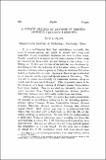A Unique Method of Defense of Bremus (Bombus) Fervidus Fabricius
Author(s)
Plath, Otto Emil
DownloadPSYCHE.1922.076186.pdf (667.5Kb)
PUBLISHER_CC
Publisher with Creative Commons License
Creative Commons Attribution
Terms of use
Metadata
Show full item recordAbstract
It is a well-known fact that bumblebees, especially the more ferocious species, are quick to attack with sting and mandibles if any vertebrate ventures too close to their nests. Similar punishment is meted out by many species if their nests are invaded by bees which do not belong to the colony, e. g. Psithyrus. In this case the fate of the intruder may be shown by describing briefly the behavior of a fair-sized colony of Bremus impatiens Cresson when a queen of Psithyrus laboriosus Fabricius enters, or is placed in, its nest. As soon as the stranger is detected on or near the comb, a general uproar arises in the colony. The intruder is seized immediately by numerous workers, stung to death, and thrown out of the nest. This, in general, seems to be the behavior of a large number of Bremus species whose habits have been studied. But, as we shall see presently, one of our most common New England bumblebees, Bremus fervidus Fabricius, behaves very differently under these conditions.
Date issued
1922Department
Massachusetts Institute of Technology. Department of BiologyJournal
Psyche: A Journal of Entomology
Publisher
Hindawi Publishing Corporation
Citation
Plath, O. E. “A Unique Method of Defense of Bremus (Bombus) Fervidus Fabricius.” Psyche: A Journal of Entomology 29, no. 4 (1922): 180–187.
Version: Final published version
ISSN
0033-2615
1687-7438